Intel NUC 13 Pro Arena Canyon Review: Raptor Lake Brings Incremental Gains
by Ganesh T S on March 27, 2023 9:00 AM ESTSystem Performance: Miscellaneous Workloads
Standardized benchmarks such as UL's PCMark 10 and BAPCo's SYSmark take a holistic view of the system and process a wide range of workloads to arrive at a single score. Some systems are required to excel at specific tasks - so it is often helpful to see how a computer performs in specific scenarios such as rendering, transcoding, JavaScript execution (web browsing), etc. This section presents focused benchmark numbers for specific application scenarios.
3D Rendering - CINEBENCH R23
We use CINEBENCH R23 for 3D rendering evaluation. R23 provides two benchmark modes - single threaded and multi-threaded. Evaluation of different PC configurations in both supported modes provided us the following results.
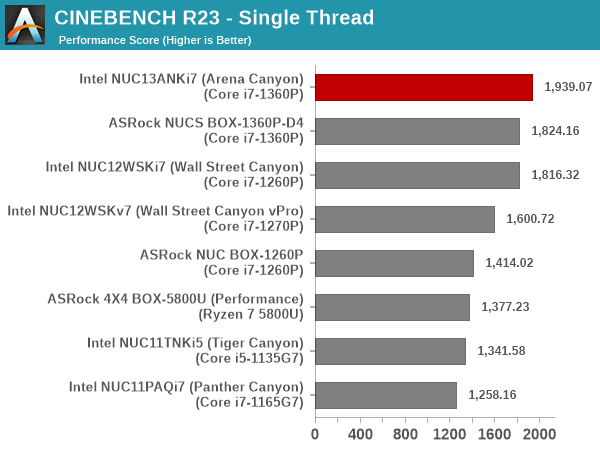
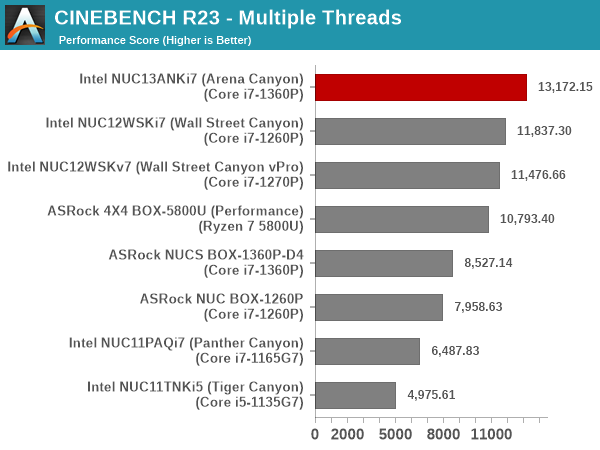
The single-thread performance for the Arena Canyon NUC and the NUCS BOX-1360P/D4 round out the top two spots, but the NUCS BOX loses out significantly in the multi-threaded case due to the lower power budget (PL1 of 28W, compared to 40W for the NUC 13 Pro).
Transcoding: Handbrake 1.5.1
Handbrake is one of the most user-friendly open source transcoding front-ends in the market. It allows users to opt for either software-based higher quality processing or hardware-based fast processing in their transcoding jobs. Our new test suite uses the 'Tears of Steel' 4K AVC video as input and transcodes it with a quality setting of 19 to create a 720p AVC stream and a 1080p HEVC stream.


Software transcoding performance is dependent on the available power budget and number of cores. The Arena Canyon NUC is on top in both of these aspects, and it is not a surprise to see it march well ahead of the competition.
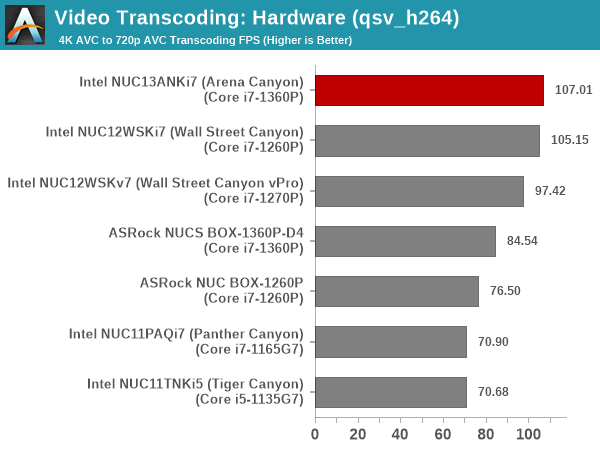
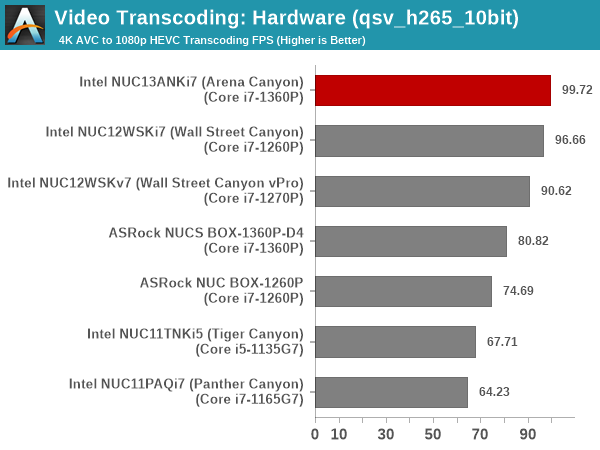
Hardware transcoding performance is dependent on the iGPU clock speeds and Raptor Lake-P is the best equipped family on that front. The extra power budget over the ASRock Industrial configuration helps the Arena Canyon NUC come out on top.
Archiving: 7-Zip 21.7
The 7-Zip benchmark is carried over from our previous test suite with an update to the latest version of the open source compression / decompression software.
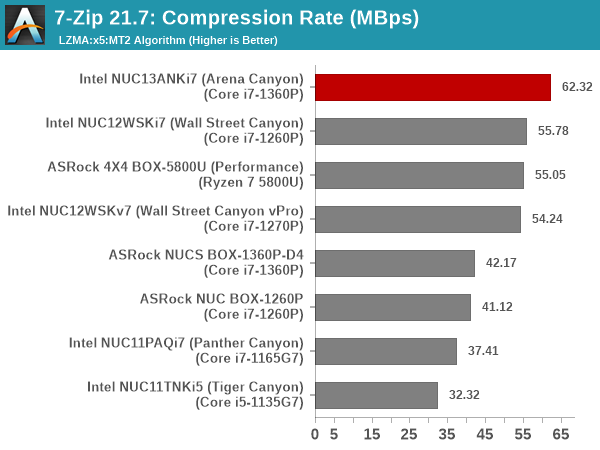
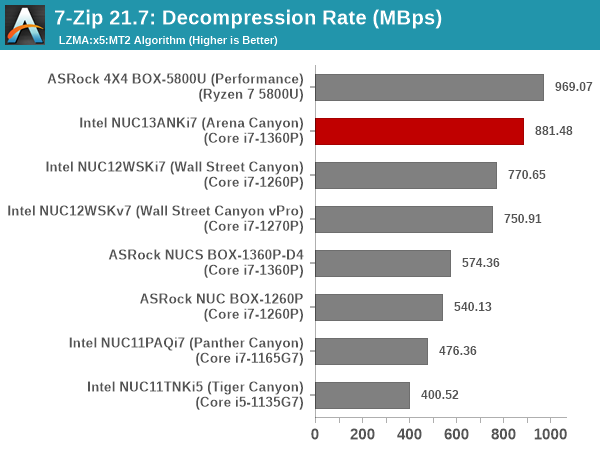
The power budget and number of cores helps the Arena Canyon NUC take the top spot in the compression component, but the Ryzen 7-5800U has enough chops to take the crown in the decompression test. Within the Intel family, the RPL-P implementation from Intel is the undisputed leader in both components.
Web Browsing: JetStream, Speedometer, and Principled Technologies WebXPRT4
Web browser-based workloads have emerged as a major component of the typical home and business PC usage scenarios. For headless systems, many applications based on JavaScript are becoming relevant too. In order to evaluate systems for their JavaScript execution efficiency, we are carrying over the browser-focused benchmarks from the WebKit developers used in our notebook reviews. Hosted at BrowserBench, JetStream 2.0 benchmarks JavaScript and WebAssembly performance, while Speedometer measures web application responsiveness.
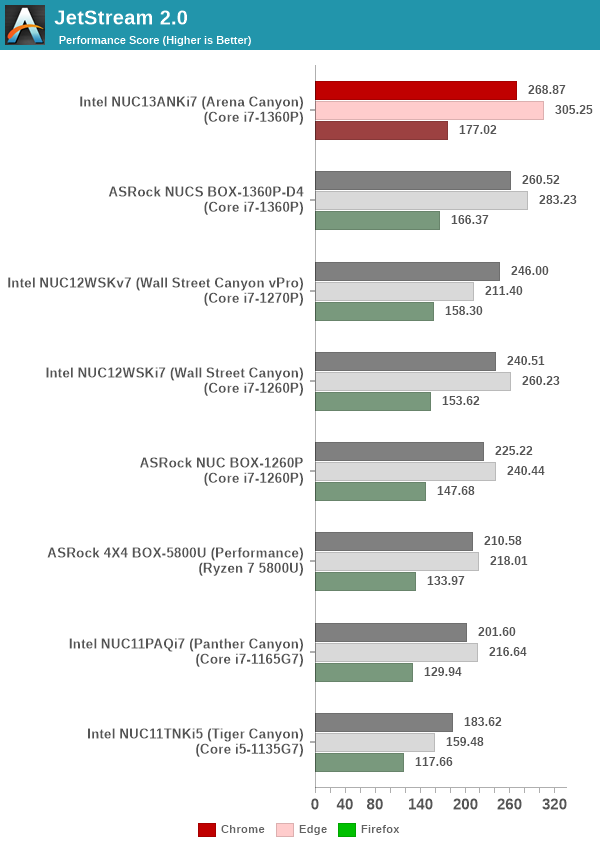

From a real-life workload perspective, we also process WebXPRT4 from Principled Technologies. WebXPRT4 benchmarks the performance of some popular JavaScript libraries that are widely used in websites.
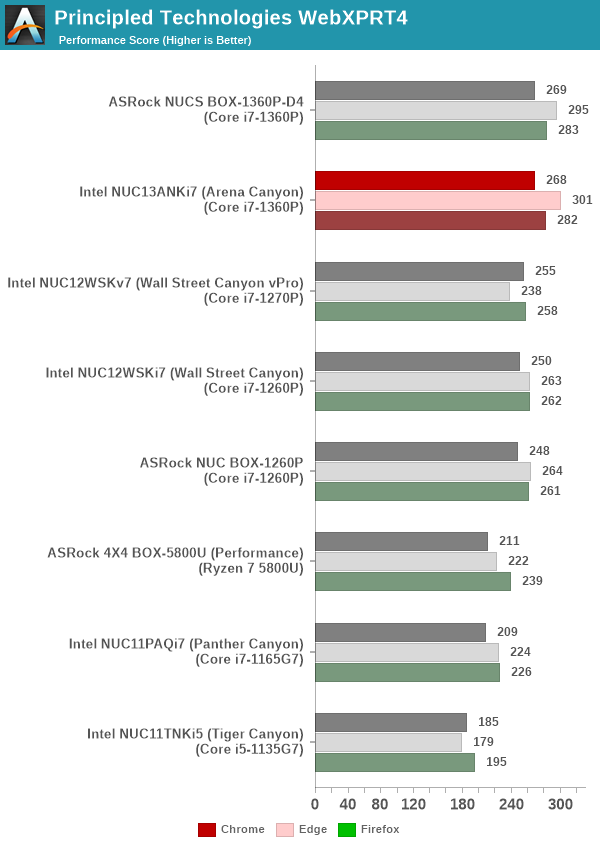
In sustained benchmarking (like in Jetstream and Speedometer), the PL1 and PL2 values influence the results allowing the Arena Canyon NUC to take the top spot. However, in the more realistic use-case with webXPRT4, the NUC 13 Pro and the ASRock Industrial NUCS BOX-1360P/D4 perform very similar to each other across different browsers.
Application Startup: GIMP 2.10.30
A new addition to our systems test suite is AppTimer - a benchmark that loads up a program and determines how long it takes for it to accept user inputs. We use GIMP 2.10.30 with a 50MB multi-layered xcf file as input. What we test here is the first run as well as the cached run - normally on the first time a user loads the GIMP package from a fresh install, the system has to configure a few dozen files that remain optimized on subsequent opening. For our test we delete those configured optimized files in order to force a fresh load every second time the software is run.
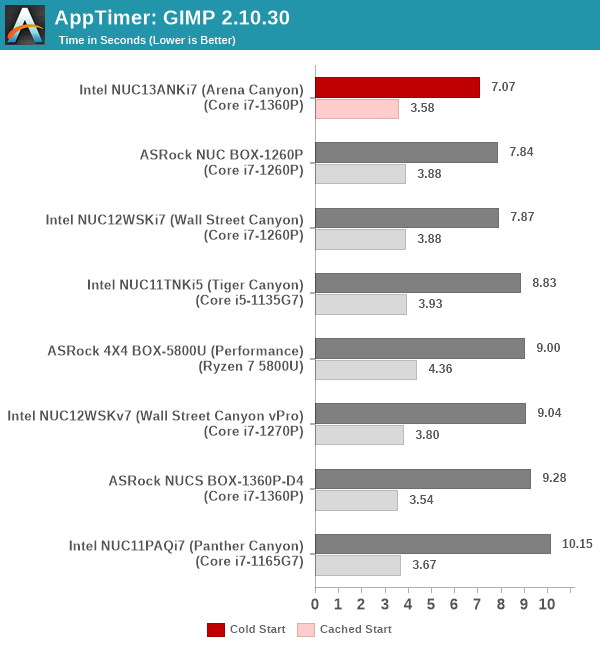
As it turns out, GIMP does optimizations for every CPU thread in the system, which requires that higher thread-count processors take a lot longer to run. So the test runs quick on systems with fewer threads, however fast cores are also needed. The cached start numbers for the ASRock Industrial system and the Arena Canyon NUC are similar, but the latter is significantly better in the cold start scenario.
Cryptography Benchmarks
Cryptography has become an indispensable part of our interaction with computing systems. Almost all modern systems have some sort of hardware-acceleration for making cryptographic operations faster and more power efficient. In the case of business use-cases, many applications such as VPN need cryptography acceleration.
BitLocker is a Windows features that encrypts entire disk volumes. While drives that offer encryption capabilities are dealt with using that feature, most legacy systems and external drives have to use the host system implementation. Windows has no direct benchmark for BitLocker. However, we cooked up a BitLocker operation sequence to determine the adeptness of the system at handling BitLocker operations. We start off with a 4.5GB RAM drive in which a 4GB VHD (virtual hard disk) is created. This VHD is then mounted, and BitLocker is enabled on the volume. Once the BitLocker encryption process gets done, BitLocker is disabled. This triggers a decryption process. The times taken to complete the encryption and decryption are recorded. This process is repeated 25 times, and the average of the last 20 iterations is graphed below.
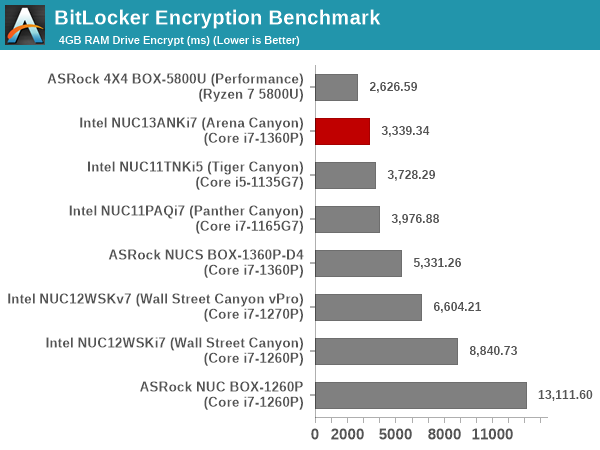
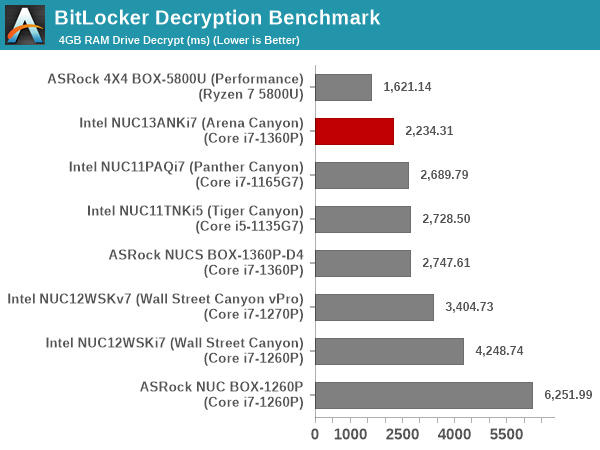
Hardware acceleration is available for the operations in all of the systems. The time taken for processing is directly dependent on the available power budget. Faster acceleration with more number of stronger cores in the Ryzen 7-5800U help the 4x4 BOX-5800U perform significantly better than the rest of the systems in this benchmark. The Arena Canyon NUC turns out to be the best of the Intel lot, as one would expect from the latest generation.










46 Comments
View All Comments
MrCommunistGen - Tuesday, March 28, 2023 - link
If you're just looking to dabble, you might check out Apple's Refurbished shop. I swear by their shop and use it to help my parents getting inexpensive iDevices as they don't need the latest and greatest.They tend to sell pretty lightly used machines that are only a generation or two old at decently discounted prices. If you buy a laptop or other mobile device, I believe that all 1st party Apple Refurbished devices get a brand new battery as part of the refurb process.
FWIW, it looks like through the refurb site you can get an M1 Mac Mini with 16GB RAM and 512GB SSD for $809. Yes, you lose out on the improvements that the M2 brings, but it saves you almost $200 too.
The M1 is going to be plenty potent compared to your... Core2 Duo(?) based Macbook?
Glaurung - Tuesday, March 28, 2023 - link
If you can't stomach apple's prices, check out refurbished/lightly used apple gear on backmarket or, for older machines you can upgrade yourself, Ebay. Apple's official refurb store is great but you will never get more than about 15% off there. I love my apple gear, but I only ever buy used/refurb, because I cannot afford the price Apple charges for new.Affectionate-Bed-980 - Tuesday, March 28, 2023 - link
For how "dead" Anandtech has been in terms of publishing GPU and CPU reviews, I'm surprised we get a NUC update and full review before this is even available for consumers!abufrejoval - Tuesday, March 28, 2023 - link
My NUC10 seems to just have burned through its Thunderbolt port: for some weeks it's lost the connection to the Sabrent/Aquantia 10Gbit NIC after a couple of days, but power cycling brought it back. Now it's just gone completely, just can't seen anything connected on TB any more.So while I needed a replacement, NUC12 is still rather expensive and I am still yearning for something Mini-ITX not NUC anyway, I hit across this one: https://elchapuzasinformatico.com/2023/03/cpu-inte... which is much cheaper than a comparable NUC of that generation.
So I just decided to order one to see if it holds water. I won't be able to reuse the RAM, but with 64GB at €120 that's no longer a pain point and it is a bit more flexible and expandable than the NUCs, while unfortunately it lacks the TB port, but will allow me to use one of my AQC107 PCIe x4 NIC in storage.
Mini-ITX with one of my Noctuas allows to raise the sustained TDP to 35 Watts without getting annoying, while idle power consumption might not be very different. That's my main beef with desktop based Mini-ITX hardware, I want the lowest idle power and then "comfortable" peak performance without getting distracted by noise, heat or electric bills.
H- and P-class SoCs from AMD and Intel basically allow that, but are hard-to-get in these smaller form factors: high-end notebooks obviously represent the more attractive sales channels and older parts are leak into these Chinese surplus channels only when laptops have switched to the next generation.
abufrejoval - Tuesday, March 28, 2023 - link
IMHO one of the biggest missing elements for several generations now has been lack of ECC support. With both "normal" and inline ECC most likely being included in the silicon, it's really just market segmentation again and a reason to go with Ryzen, if ECC support on their APUs wasn't such a lottery game, too.64GB is half a billion bits where things can go wrong and I just like the odds less and less...
Up2Trix - Wednesday, April 19, 2023 - link
@abufrejoval: I agree 100%. ECC DRAM is the single most important hardware feature that most people need but don't have a clue about. I curse Intel for segmenting it out of existence, and AMD for not promoting it. May the world wake up...Anyone know of a small form factor / NUC like computer with ECC support? Intel's NUC 9 Pro / Quartz Canyon from 2019 is the only one that I can readily find.
Fenturi - Tuesday, March 28, 2023 - link
I'm not sure the price/performance is here for this one vs chips like 6800HX with a much better igpu. That said two thunderbolt ports are very interesting for my use case and would be the best feature.abufrejoval - Tuesday, March 28, 2023 - link
I see the 96EU Xe doing 5-25% better than the 5800U iGPU and iGPUs typically get Wattage priority over CPUs so a "H" class iGPUs don't do better than "U", no matter if I operate the SoC at 15-28 (AMD) or 15-64 Watt (Tiger Lake NUC).So the 6800 generational uplift may just put AMD ever so slightly in the lead again, but in a race of sloths vs turtles.
For TB I keep hearing that many of the USB4 ports on AMD APUs are actually TB capable and only lack certifications... Have not had a chance to verify that.
I can't mix AMD and Intel in my clusters, so it's too late for me to switch. But the other thing is that I needed 10Gbit and for that TB sadly was a must, because for some crazy reason vendors believe 1/2.5Gbit is adequate for NVMe systems.
I've wanted mobile SoC based mainboards with PC type flexibilty for years, but only some crazy Chinese companies are selling that.
Fenturi - Tuesday, March 28, 2023 - link
Sadly, as someone who has built my own systems going back to 486 CPUs and outrageous fast wide SCSI and a super expensive video card.I think the days of building desktop PC is in it's last days.
Most people are going to only need small nuk sized units that will do most of what they need.
abufrejoval - Tuesday, March 28, 2023 - link
I can beat that, started with an 80286 (actually with an Apple ][ clone before that) and SCSI fast, wide or dual channel came much later, it was MFM and RLL before, using PIO, because the 8-bit DMA from the original PC simply wasn't fast enough for anything beyond floppy. BTW that system cost me more than a new middle class car would have and the people and shops selling them, would reflect that (suits, ties and talk): Those weren't just another microwave like box at the mall.Yes, after more than 4 decades the PC era is drawing to a close, but I'm not sure it's from lack of scale at the desktop: it's ARM from above and below that will spell the end of the x86 evolution.
There are way more PC enthusiasts today than there were PC users when we got hooked and custom builds just never scale: IKEA!
To me the real successor of the PC is the smartphone, but only if it isn't actually an Apple or Google remote control.